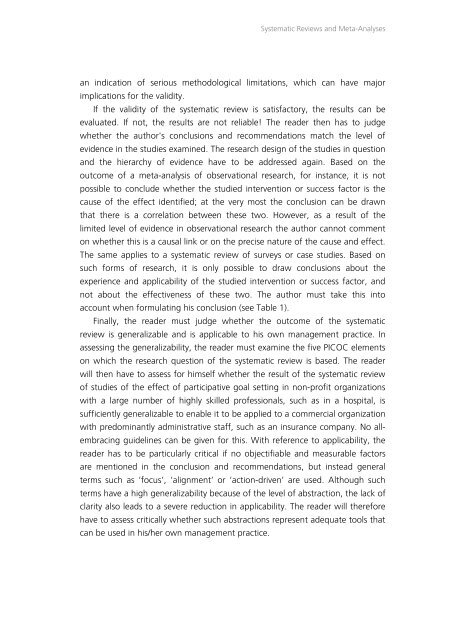In Search of Evidence
jqluvth
jqluvth
You also want an ePaper? Increase the reach of your titles
YUMPU automatically turns print PDFs into web optimized ePapers that Google loves.
Systematic Reviews and Meta-Analyses<br />
an indication <strong>of</strong> serious methodological limitations, which can have major<br />
implications for the validity.<br />
If the validity <strong>of</strong> the systematic review is satisfactory, the results can be<br />
evaluated. If not, the results are not reliable! The reader then has to judge<br />
whether the author's conclusions and recommendations match the level <strong>of</strong><br />
evidence in the studies examined. The research design <strong>of</strong> the studies in question<br />
and the hierarchy <strong>of</strong> evidence have to be addressed again. Based on the<br />
outcome <strong>of</strong> a meta-analysis <strong>of</strong> observational research, for instance, it is not<br />
possible to conclude whether the studied intervention or success factor is the<br />
cause <strong>of</strong> the effect identified; at the very most the conclusion can be drawn<br />
that there is a correlation between these two. However, as a result <strong>of</strong> the<br />
limited level <strong>of</strong> evidence in observational research the author cannot comment<br />
on whether this is a causal link or on the precise nature <strong>of</strong> the cause and effect.<br />
The same applies to a systematic review <strong>of</strong> surveys or case studies. Based on<br />
such forms <strong>of</strong> research, it is only possible to draw conclusions about the<br />
experience and applicability <strong>of</strong> the studied intervention or success factor, and<br />
not about the effectiveness <strong>of</strong> these two. The author must take this into<br />
account when formulating his conclusion (see Table 1).<br />
Finally, the reader must judge whether the outcome <strong>of</strong> the systematic<br />
review is generalizable and is applicable to his own management practice. <strong>In</strong><br />
assessing the generalizability, the reader must examine the five PICOC elements<br />
on which the research question <strong>of</strong> the systematic review is based. The reader<br />
will then have to assess for himself whether the result <strong>of</strong> the systematic review<br />
<strong>of</strong> studies <strong>of</strong> the effect <strong>of</strong> participative goal setting in non-pr<strong>of</strong>it organizations<br />
with a large number <strong>of</strong> highly skilled pr<strong>of</strong>essionals, such as in a hospital, is<br />
sufficiently generalizable to enable it to be applied to a commercial organization<br />
with predominantly administrative staff, such as an insurance company. No allembracing<br />
guidelines can be given for this. With reference to applicability, the<br />
reader has to be particularly critical if no objectifiable and measurable factors<br />
are mentioned in the conclusion and recommendations, but instead general<br />
terms such as ‘focus’, ‘alignment’ or ‘action-driven’ are used. Although such<br />
terms have a high generalizability because <strong>of</strong> the level <strong>of</strong> abstraction, the lack <strong>of</strong><br />
clarity also leads to a severe reduction in applicability. The reader will therefore<br />
have to assess critically whether such abstractions represent adequate tools that<br />
can be used in his/her own management practice.


